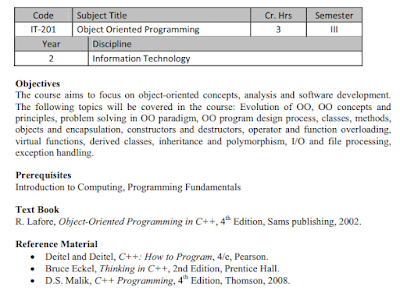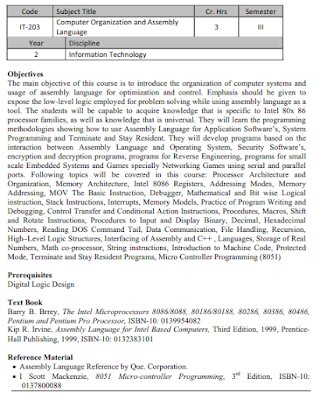BS IT 3rd Semester Outline - Govt. Islamia College Civil Lines - Govt. M.A.O. Graduate College || Affiliated by Punjab University
IT-201 | Object Oriented Programming:
Objectives:
The course aims to focus on object-oriented concepts, analysis and software development.
The following topics will be covered in the course: Evolution of OO, OO concepts and
principles, problem solving in OO paradigm, OO program design process, classes, methods,
objects and encapsulation, constructors and destructors, operator and function overloading,
virtual functions, derived classes, inheritance and polymorphism, I/O and file processing,
exception handling.
Prerequisites:
Introduction to Computing, Programming Fundamentals
Text Book
R. Lafore, Object-Oriented Programming in C++, 4th Edition, Sams publishing, 2002.
Reference Material:
- Deitel and Deitel, C++: How to Program, 4/e, Pearson.
- Bruce Eckel, Thinking in C++, 2nd Edition, Prentice Hall.
- D.S. Malik, C++ Programming, 4th Edition, Thomson, 2008.
MATH-231 | Discrete Mathematics (IT):
Objectives:
This course introduces the foundations of discrete mathematics as they apply to Computer
Science, focusing on providing a solid theoretical foundation for further work. It aims to
develop understanding and appreciation of the finite nature inherent in most Computer
Science problems and structures through study of combinatorial reasoning, abstract algebra,
iterative procedures, predicate calculus, tree and graph structures. The following topics will
be covered in the course: Introduction to logic and proofs, Direct proofs, proof by
contradiction, Sets, Combinatorics, Sequences, Formal logic, Prepositional and predicate
calculus, Methods of Proof, Mathematical Induction and Recursion, loop invariants,
Relations and functions, Pigeon whole principle, Trees and Graphs, Elementary number
theory, Optimization and matching, Fundamental structures, Functions (surjections,
injections, inverses, composition), relations (reflexivity, symmetry, transitivity, equivalence
relations), sets (Venn diagrams, complements, Cartesian products, power sets), pigeonhole
principle; cardinality and countability
Prerequisites:
None
Text Book:
Rosen, Discrete Mathematics and Its Applications, 5th edition, McGraw-Hill, ISBN:
0072424346
Reference Material:
- Richard Johnsonbaugh, Discrete Mathematics, Prentice Hall, ISBN: 0135182425
- Kolman, Busby & Ross, Discrete Mathematical Structures, 4th Edition, 2000, Prentice-Hall, ISBN: 0130831433
ARB-212 | Arabic Language:
Objectives:
The main objective of this course is to give students an introduction to the basic syntax and
morphology of the Arabic language so that they can study the language at an advanced level
on their own. At the end of the course students will be in a position to understand simple
Arabic sentences and decipher the meaning of complex sentences to some extent with the
help of a dictionary. Although the main stress shall be on explaining the sentence structure, it
is expected that some use of Situational Language Teaching (SLT) and communication will
also give the students a limited ability to read Arabic texts and communicate in that language.
ENG‐231 | Communication Skills (IT):
Objectives:
The aim of this course is to develop good English writing, language usage and reading skills,
to appreciate the importance of business communication and to develop understanding of
communication concepts, principles, theories and problems. It will also help in developing
good oral communication and presentation skills. The following topics will be covered in the
course: Principles of writing good English, understanding the composition process,
Comprehension and expression, Use of grammar and punctuation, Process of writing,
observing, audience collecting, composing, drafting and revising, persuasive writing, reading
skills, listening skills and comprehension, skills for taking notes, Business communications,
planning messages, writing concise but with impact, Letter formats, mechanics of business,
letter writing, letters, memo and applications, summaries, proposals, writing resumes, styles
and formats, oral communications, verbal and nonverbal communication, conducting
meetings, small group communication, taking minutes, Presentation skills, Presentation
strategies, material gathering, material organization strategies, time management, opening
and concluding, use of audio-visual aids, delivery and presentation.
Text Book:
Vawdrey, Stoddard, Bell, Practical Business English, ISBN-10: 0256102740
Recommended Book:
Herta A. Murphy, Effective Business Communication, ISBN-10: 007044398X
IT-203 | Computer Organization and Assembly Language:
Objectives:
The main objective of this course is to introduce the organization of computer systems and
usage of assembly language for optimization and control. Emphasis should be given to
expose the low-level logic employed for problem solving while using assembly language as a
tool. The students will be capable to acquire knowledge that is specific to Intel 80x 86
processor families, as well as knowledge that is universal. They will learn the programming
methodologies showing how to use Assembly Language for Application Software’s, System
Programming and Terminate and Stay Resident. They will develop programs based on the
interaction between Assembly Language and Operating System, Security Software’s,
encryption and decryption programs, programs for Reverse Engineering, programs for small
scale Embedded Systems and Games specially Networking Games using serial and parallel
ports. Following topics will be covered in this course: Processor Architecture and
Organization, Memory Architecture, Intel 8086 Registers, Addressing Modes, Memory
Addressing, MOV The Basic Instruction, Debugger, Mathematical and Bit wise Logical
instruction, Stack Instructions, Interrupts, Memory Models, Practice of Program Writing and
Debugging, Control Transfer and Conditional Action Instructions, Procedures, Macros, Shift
and Rotate Instructions, Procedures to Input and Display Binary, Decimal, Hexadecimal
Numbers, Reading DOS Command Tail, Data Communication, File Handling, Recursion,
High–Level Logic Structures, Interfacing of Assembly and C++ , Languages, Storage of Real
Numbers, Math co-processor, String instructions, Introduction to Machine Code, Protected
Mode, Terminate and Stay Resident Programs, Micro Controller Programming (8051)
Prerequisites:
Digital Logic Design
Text Book:
Barry B. Brrey, The Intel Microprocessors 8086/8088, 80186/80188, 80286, 80386, 80486,
Pentium and Pentium Pro Processor, ISBN-10: 0139954082
Kip R. Irvine, Assembly Language for Intel Based Computers, Third Edition, 1999, PrenticeHall Publishing, 1999, ISBN-10: 0132383101
Reference Material:
- Assembly Language Reference by Que. Corporation.
- I Scott Mackenzie, 8051 Micro-controller Programming, 3rd Edition, ISBN-10: 0137800088
IT-204 | Computer Organization and Assembly Language Lab:
Objectives:
Instruction set architecture. Accumulator based, Stack Based and General Purpose Register
Organization. Processor’s Data Path. Design of a basic computer highlighting the timing and
control system in instruction execution cycle. Interrupts, traps and signals. Comparison of
Intel 80x86 and MIPS architectures. Addressing Modes. Mapping of High level language to
corresponding assembly and machine language. Memory and Cache organization techniques.
I/O techniques (Memory mapped and isolated I/O). Latest trends in Architectures.
Prerequisites:
Digital Logic Design
Text Book:
Kip R. Irvine, Assembly Language for Intel Based Computers, Third Edition, 1999, PrenticeHall Publishing, 1999, ISBN-10: 0132383101
Reference Material:
- Assembly Language Reference by Que. Corporation.
IT-202 | Object Oriented Programming Lab:
Objectives:
The course aims to focus on object-oriented concepts, analysis and software development. The following topics will be covered in the course: Evolution of OO, OO concepts and principles, problem solving in OO paradigm, OO program design process, classes, methods, objects and encapsulation, constructors and destructors, operator and function overloading, virtual functions, derived classes, inheritance and polymorphism, I/O and file processing, exception handling.
Prerequisites:
Introduction to Computing, Programming Fundamentals Text Book R. Lafore, Object-Oriented Programming in C++, 4th Edition, Sams publishing, 2002.
Reference Material:
- Deitel and Deitel, C++: How to Program, 4/e, Pearson.
- Bruce Eckel, Thinking in C++, 2nd Edition, Prentice Hall.
- D.S. Malik, C++ Programming, 4th Edition, Thomson, 2008.

.PNG)

.PNG)

Comments
Post a Comment